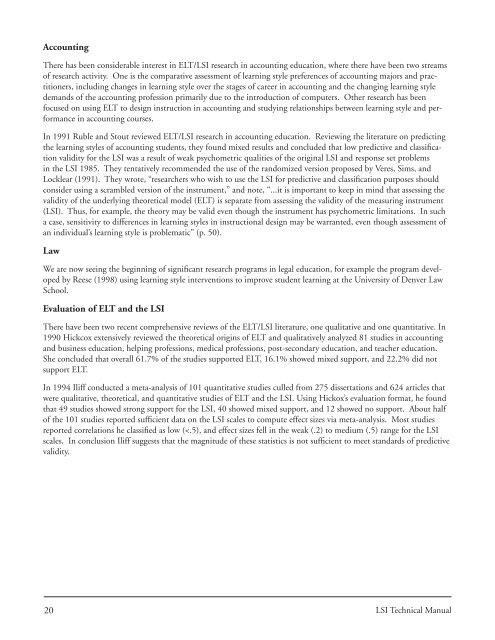The Kolb Learning Style Inventory—Version 3.1 2005 - Whitewater ...
The Kolb Learning Style Inventory—Version 3.1 2005 - Whitewater ...
The Kolb Learning Style Inventory—Version 3.1 2005 - Whitewater ...
You also want an ePaper? Increase the reach of your titles
YUMPU automatically turns print PDFs into web optimized ePapers that Google loves.
Accounting<br />
<strong>The</strong>re has been considerable interest in ELT/LSI research in accounting education, where there have been two streams<br />
of research activity. One is the comparative assessment of learning style preferences of accounting majors and practitioners,<br />
including changes in learning style over the stages of career in accounting and the changing learning style<br />
demands of the accounting profession primarily due to the introduction of computers. Other research has been<br />
focused on using ELT to design instruction in accounting and studying relationships between learning style and performance<br />
in accounting courses.<br />
In 1991 Ruble and Stout reviewed ELT/LSI research in accounting education. Reviewing the literature on predicting<br />
the learning styles of accounting students, they found mixed results and concluded that low predictive and classifi cation<br />
validity for the LSI was a result of weak psychometric qualities of the original LSI and response set problems<br />
in the LSI 1985. <strong>The</strong>y tentatively recommended the use of the randomized version proposed by Veres, Sims, and<br />
Locklear (1991). <strong>The</strong>y wrote, “researchers who wish to use the LSI for predictive and classifi cation purposes should<br />
consider using a scrambled version of the instrument,” and note, “...it is important to keep in mind that assessing the<br />
validity of the underlying theoretical model (ELT) is separate from assessing the validity of the measuring instrument<br />
(LSI). Thus, for example, the theory may be valid even though the instrument has psychometric limitations. In such<br />
a case, sensitivity to differences in learning styles in instructional design may be warranted, even though assessment of<br />
an individual’s learning style is problematic” (p. 50).<br />
Law<br />
We are now seeing the beginning of signifi cant research programs in legal education, for example the program developed<br />
by Reese (1998) using learning style interventions to improve student learning at the University of Denver Law<br />
School.<br />
Evaluation of ELT and the LSI<br />
<strong>The</strong>re have been two recent comprehensive reviews of the ELT/LSI literature, one qualitative and one quantitative. In<br />
1990 Hickcox extensively reviewed the theoretical origins of ELT and qualitatively analyzed 81 studies in accounting<br />
and business education, helping professions, medical professions, post-secondary education, and teacher education.<br />
She concluded that overall 61.7% of the studies supported ELT, 16.1% showed mixed support, and 22.2% did not<br />
support ELT.<br />
In 1994 Iliff conducted a meta-analysis of 101 quantitative studies culled from 275 dissertations and 624 articles that<br />
were qualitative, theoretical, and quantitative studies of ELT and the LSI. Using Hickox’s evaluation format, he found<br />
that 49 studies showed strong support for the LSI, 40 showed mixed support, and 12 showed no support. About half<br />
of the 101 studies reported suffi cient data on the LSI scales to compute effect sizes via meta-analysis. Most studies<br />
reported correlations he classifi ed as low (


